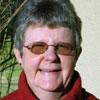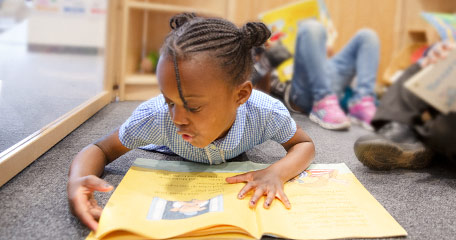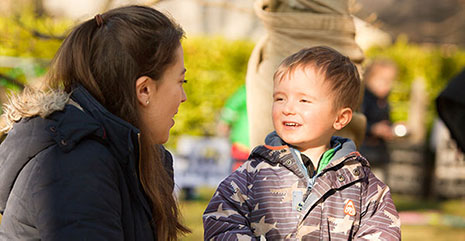Inspiring reading
Children with special educational needs, books and reading
| January 2018If you ask an adult for their earliest memory of stories, books and reading they will often recall the oral tales told by parents, grandparents or the “classic” stories, which adults read to young children. However, since the Industrial Revolution, governments and some employers are often quoted as seeing a decline in literacy, which in turn affects our nation’s ability to compete with the world. (Brown, 2007).
The development of early language and literacy begins in the first three years of life and is closely linked to a child's earliest experiences with books and stories. Young children come into contact with a range of materials including books, paper, and crayons. Together with the adults in their lives they are the important building blocks for language, reading and writing development. Current research demonstrates the critical role of these early experiences in shaping brain development.

Views on learning literacy:
Learning to communicate and to read has changed dramatically and most recently due to digital technology. Vygotsky (1987) states that learning is a social phenomenon and emphasises that the learner must be involved in the whole activity as a meaningful context rather than discrete parts. This view supports the holistic approach to learning literacy based upon the fundamental assumption that reading and writing are learnt from whole to part (Goodman, 1986); (Goodman and Goodman, 1979). Learners should understand and experience the purposes and functions of language before learning to manipulate its constituent parts. Oral and written language have to be learned in meaningful and enjoyable circumstances, and thus children construct language as they use it. So in holistic approaches the child has the lead and the approaches vary between individuals in multiple contexts and via multiple interpretations. Harste et al., (1984), Cambourne and Turbill (1987) suggest that certain conditions support this approach with children, such as immersion in print, demonstration of how print and books are used, and encouraging children to explore through approximate and practical ways of using reading and writing meaningfully whilst giving supportive and instructive feedback.
Whereas the numerous and popular skills-based approaches – as seen in many intervention programmes in schools – tackle literacy from a hierarchical or linear perspective. Thus learning to talk, read and write becomes the acquisition and mastery of a range of skills from simple to complex. These interventions are also favoured by those who believe that children who struggle to read and write are badly taught, and this has resulted in confusion for the general public and practitioners who struggle to decide which is the “right” choice.
“Nurture shapes nature”
Within the Early Years there is a great deal of evidence which demonstrates what neuroscientist Colin Blakemore (2001) describes as “nurture shapes nature”. So our biological selves are shaped and formed by people, relationships and culture. Where reading and writing are concerned this is particularly achieved through learning to walk, talk and play with others, which are all important and essential developmental processes. Literacy is a social skill and babies and children learn by watching, listening and eventually talking with others about sounds, words, pauses, silences, turn-taking and imitation.
Physicality matters too. As babies learn to crawl, their eyes start to co-ordinate in ways that will later track texts (Greenland, 2006; Bruce and Meggit, 2007). The co-ordination of both large and small movements is also vital, and leads to walking and many other motor skills. Therefore many children with individual special educational needs or disabilities will need careful consideration and time when learning to read and write.
Children also learn to become symbol makers and users as they start to make sense of the world around them and come to understand that symbols stand for other things and hold meanings. Thus if you have certain disabilities or individual needs, the sensitive use of tactile exploration of clay, sand, water, dough and so on – alongside digital technology, music, dance and art – may widen your opportunities to experience symbols in their diverse forms.
Giving children an appreciation of a wide range of literature underpins and supports their development of understanding in reading by providing meaningful experience of rhythm, sequence and narrative, tone and intonation, pauses, rhyme, and alliteration. Stories and poems help children understand sequence and narrative, as well as creating meaning, writing sentences, composing their own stories, and making their own non-fiction books based on their interests.

Early literacy research states that:
- Language, reading, and writing skills develop at the same time and are intimately linked;
- Early literacy development is a continuous developmental process that begins in the early years;
- Early literacy skills develop in real-life settings through positive interactions with literacy materials and other people.
Therefore a broad, deep and rich curriculum as advocated by the Early Years Foundation Stage should ensure an environmentally rich literacy context, which gives children many opportunities for:
- Movement and developmentally appropriate experiences of both large and fine motor skills;
- Exploration of three dimensional props and books; and
- Real experiences of books, rhymes etc.
Using books:
Children with individual needs will need support in developing a range of appropriate behaviours with books. These will include:
- The physical manipulation or handling of books, such as page turning rather than chewing, tearing or throwing them;
- Learning to look at and pay attention to pictures in books;
- Learning to show recognition of and a beginning of understanding of pictures in books, such as pointing to pictures of familiar objects;
- Gaining an understanding of pictures, events and story comprehension such as imitating an action seen in a picture or talking about the events in a story; and
- Verbally interacting with stories and books alongside increasing their understanding of print in books such as babbling in imitation of reading or running fingers along printed words.
Tuning into language:
Developing language and communication skills via conversation is crucial in learning to read as Montessori recognised (2007a, 2007b). She encouraged the use of rich, appropriate vocabulary in meaningful contexts by parents and practitioners “tuning into children’s language”. Spoken language and listening underpin so much of what is expected within the school system, such as listening to what is said, acting upon it, responding appropriately, initiating actions, asking questions and problem-solving via sustained shared thinking. As reading and writing as normally used in school are two examples of decontextualized language use, it is to be expected that children with individual needs may show considerable variability in the speed and ease with which they are acquired.
The value of books:
Exposure to books and storytelling are also essential cornerstones in preparing to learn to read and write as well as learning how to learn in school. The first picture-word books, with single words printed under easily identifiable pictures, have the effect of providing children with a physical context which can, in combination with the experience of being read to, support word reading. Clues help children: Dr. Seuss books often provide examples of graphic text (“so so so so” printed diagonally across the page in The Cat in the Hat; “Sam I am” printed on the sign carried by Sam in Green Eggs and Ham) that identify the word physically.
The importance of choosing inclusive books:
Access to good quality books, both children’s literature and reference material, is essential if children with special needs and disabilities are to build a good foundation of reading in their early years. We know that children absorb messages (negative as well as positive) very quickly, so these books should be comprehensible, attractive, well-illustrated, non-sexist and non-racist. Ideally they should also include children like themselves so they are motivated to use them, to want to turn the pages, to look at the pictures, to listen to the story.
It is also important to provide well-illustrated books with “skilful and compelling illustrations” (Nutbrown 1994); and as well as illustrations the text itself is clearly important. The best books are clear, well written with poetic and memorable turns of phrase and absorbing storylines.
The different layers within stories are an important feature of well-written books, which hold children’s interest: Margaret Meek (1988) talks about the “multi-consciousness” of books where they contain more than one thing, perhaps more than one story. She gives the example of Rosie’s Walk by Pat Hutchins, where the words tell a simple story of a hen going for a walk around the farmyard. It is the illustrations, which make the story clear with Rosie the hen being followed by a fox that wants to eat her for his lunch. The text does not refer to the fox, but the presence of the fox is fundamental to the reader’s experience. Thus a well-written book will have a storyline, which either fascinates or bores a child. Through it they will discover more about themselves and they may also experience different feelings and thoughts as well as a desire to extend their knowledge. Sharing books leads to joint pleasure if the book has a rhythmic refrain such as “Once upon a bicycle so they say” in the Ahlberg’s The Jolly Postman or the simple repetition of a pop-up book like Claverie and Price’s Peek-a-boo.
Children need to be given the widest opportunities to choose books that have been thoughtfully produced, and they need fiction and non-fiction books to extend, enrich and stimulate their learning. Whilst some children will have such books at home, others may not, and it is for these children in particular that practitioners need to provide the very best books and book talk, and have methods of exploring with parents ways that books and talk can be used at home, building upon their interests and needs as a team. (Weinberger, 1996).

Encouraging children with special educational needs to enjoy books
A climate of fun and multi-sensory experience that is based in children’s interests is key to making books and reading enjoyable. Ideally practitioners should not be building barriers but breaking them down according to the unique needs of the children. These can be assisted by the following ideas:
- Encouraging a variety of reading role-models to boost self-esteem alongside skills, e.g. older children and parents.
- Using books with a range of positive images so children can recognize themselves and children like them, including making books about them.
- Bringing in real authors, poets and illustrators to share their enthusiasm, having researched their ability to communicate with the children in your school/setting.
- Providing daily routines such as story times every day in comfortable environments, alongside flexibility (e.g. indoors and outside). Some children with particular needs may need one-to-one stories using such useful tools as multi-sensory Book Boxes in order to understand the concept of story time.
- Providing opportunities to use established skills e.g. book handling, illustrating stories.
- Developing multi-sensory activities with visuals, puppets, props and lots of active participation to make book reading both fun and memorable.
- A chatterbox can be made from any reasonably tough box and the inside of the box is 'landscaped' and equipped appropriately. For example, a Three Bears box might contain three bears of varying sizes, a girl figure and bowls, chairs and beds to suit. On one wall of the box might be some textured green material with trees whilst on another is a cottage interior. The children can re-enact the story in different ways and create different endings and plot twists. A chatterbox need not be book-related. It may contain a range of figures on a theme to invite the children to use their imaginations and tell and develop the tales that occur to them.
- Using story sacks with a range of prop contents to capture involvement and interest. A story sack is a bag containing a book, plus items associated with the story, which might include characters in the form of soft toys or puppets. There might also be a non-fiction book on a similar theme, which allows children to experience different types of text. These items are used to help bring the story to life. They provide a visual and tactile stimulus that the children can use to take part in the telling or re-telling of the story. Children of all abilities enjoy using them but they can be particularly useful in helping children who are not interested in reading – for whatever reasons – to enjoy books. You can make your own story bag and include whatever you feel is appropriate for the children who will be using it.
- Re-telling stories over and over again is important too. Get the children to use the characters from the bag to re-tell the story. This is where the size of your group can be important because it is wise for all the children to be involved. Your focus for the session may vary but here are some ideas to explore:
- Re-tell the story as it is;
- Re-tell the story and change the ending;
- Discuss the characters, who do they like best/least and why?;
- Think of other stories with similar characters and discuss their characters, i.e. good or bad; or
- Re-tell the story with different characters.
- Use dress-up days with book character costumes for special events such as Book Week.
- Act out stories, poems and non-fiction books.
- Providing head and shoulder massage to soothe particularly agitated children so they can relax and listen.

Conclusion:
Teaching language and literacy via the use of books demands the highest quality teaching. This in turn requires knowledge, insight and curiosity about how children learn and develop alongside their unique interests and needs. Practitioners need to display a genuine commitment to holistic learning alongside joyful, playful teaching and learning. They will also need a problem-solving disposition themselves and a ‘can-do’ attitude in order to ensure that all children have the opportunity to enjoy books and communication in every sense.
Bibliography:
Ahlberg, A., and Ahlberg, J. (1986). The Jolly Postman. London:Heinemann.
Claverie, J., and Price, M. (1993). Peek-a-book. Harmondsworth: Penguin:
Blakemore, C. (2001). ‘What makes a developmentally appropriate early childhood curriculum?’ Lecture given at the Royal Society of Arts, 14 February.
Brown, G. (2007). The Mansion House Speech, City Hall, London, 20 June.
Bruce, T. and Meggit, C. (2007). Childcare and Education (5th ed.). London: Arnold.
Bruce, Tina and Spratt, Jenny (2008). Essentials of Literacy from 0-7. London: Sage.
Cambourne, B. and Turbill, J. (1987). Coping with Chaos. Portsmouth, NH: Heinemann.
Goodman, K.S. (1986). What’s whole in whole language? Portsmouth, NH: Heinemann.
Goodman, K.S. and Goodman, Y.M. (1979). Learning to read is natural, in L.B. Resnick and P.A. Weaver editors. Theory and Practice of Early Reading. v1. pp. 137-154). Hillsdale, N.J: Erlbaum.
Greenland, P. (2006). Physical Development, in T. Bruce, editor. Early Childhood: A Guide for Students, London: Sage.
Harste, J.C., Woodward, V.A. and Burke, C.L., (1984). Language stories and literacy lessons. Portsmouth, NH: Heinemann.
Isaacs, B. (2012). Understanding the Montessori Approach. Abingdon: Routledge.
Nutbrown, C. (1994). Threads of Thinking: Young children learning and the role of early education. London: Paul Chapman.
Meek, M. (1982). Learning to read. London: The Bodley Head.
Meek, M. (1988). How texts teach what readers learn. Stroud: Thimble Press.
Montessori, M. (2007a) The Absorbent Mind. Amsterdam: Montessori-Pierson, v1.
Montessori, M. (2007b) The Discovery of the Child (originally published as The Montessori Method). Amsterdam: Montessori-Pierson, v2. S
Chickedanz, (1999) Much more than the ABCs: The early stages of reading and writing. Washington, DC: NAEYC.
Vygotsky, L. (1987) Mind in Society: The Development of Higher Psychological Processes. Cambridge, M.A.: Harvard University Press.
Weinberger, J. (1996) Literacy goes to school – the parents’ role in young children’s literacy learning. London: Paul Chapman
Whitehead, M. (2001) Supporting Language and Literacy Development in the Early Years. Buckingham: Open University Press.
Follow-up contacts/ideas:
Bag Books-multisensory stories office@bagbooks.org 1 Stewart’s Court, 218 - 220 Stewart’s Road, London SW8 4UB Telephone: 020 7627 0444 / Fax: 020 7627 0999
Story sacks by the originator Neil Griffith: Demco, (0)1992 45 46 36 (0)1992 44 89 89 Grange House, 2 Geddings Road, Hoddesdon, Hertfordshire, EN11 0NT
Inclusive booklists: www.bookstart.org.uk/books/booklists/32/
National Literacy Trust: www.literacytrust.org.uk
First published in Montessori International Spring 2016 – used with permission of the author.






